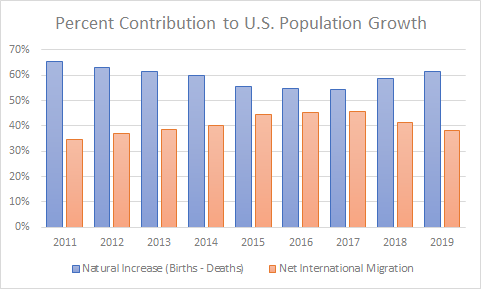Earlier this week the Census Bureau released national and state population estimates. Some key take-aways:
- U.S. population continues to slow. U.S. Population increased 0.48% between July 1, 2018 and July 1, 2019. This is the slowest growth rates since 1918.
- Nature increase (births minus deaths) continue to slow. S. births fell 0.9 percent in 2019, the fourth consecutive year of decline. Deaths increased 0.4 percent in 2019. The natural increase fell below 1 million in 2019 for the first time in decades.
- Net international immigration is also declining. Net immigration declined to 595,348 in 2019, the lowest level in a decade. Net international immigration has been declining annually since 2016. China replaced Mexico to become the largest sending country of foreign-born immigrants to the United States as of 2018.

Other interesting details:
- 42 states and the District of Columbia had fewer births in 2019 than 2018. Eight states saw increases in births – Washington (612), Utah (293), Nevada (232), Arizona (175), Idaho (166), Montana (66), Vermont (44), and Colorado (30).
- Four states had more deaths than births (natural decrease): West Virginia (-4,679), Maine (-2,262), New Hampshire (-121) and Vermont (-53).
- The Northeast region saw its population decrease for the first time in decades
- The South, the largest of the four regions, saw the largest numeric growth (1,011,015) and percentage growth (0.8%) between 2018 and 2019
- Ten states lost population between 2018 and 2019: New York (-76,790; -0.4%), Illinois (-51,250; -0.4%), West Virginia (-12,144; -0.7%), Louisiana (-10,896; -0.2%), Connecticut (-6,233; -0.2%), Mississippi (-4,871; -0.2%), Hawaii (-4,721; -0.3%), New Jersey (-3,835; 0.0%), Alaska (-3,594; -0.5%), and Vermont (-369 ; -0.1%).
- Over the last decade, five of the fastest growing states have been in the Mountain states. Utah was the fastest growing state in the country, followed by Colorado (3rd), Nevada (4th), Idaho (6th), and Arizona (7th).
While technological shifts will help shape the future of work, demographic shifts will also define not only what work is, but where to find it. Population growth is slowing at the same time that domestic migration or internal migration (movement between states) is slowing to record low levels. These are some of the demographic trends playing out as the digital economy rolls forward. These trends will interact in interesting ways in the coming years.
Cross-posted at ShawnDuBravac.com
